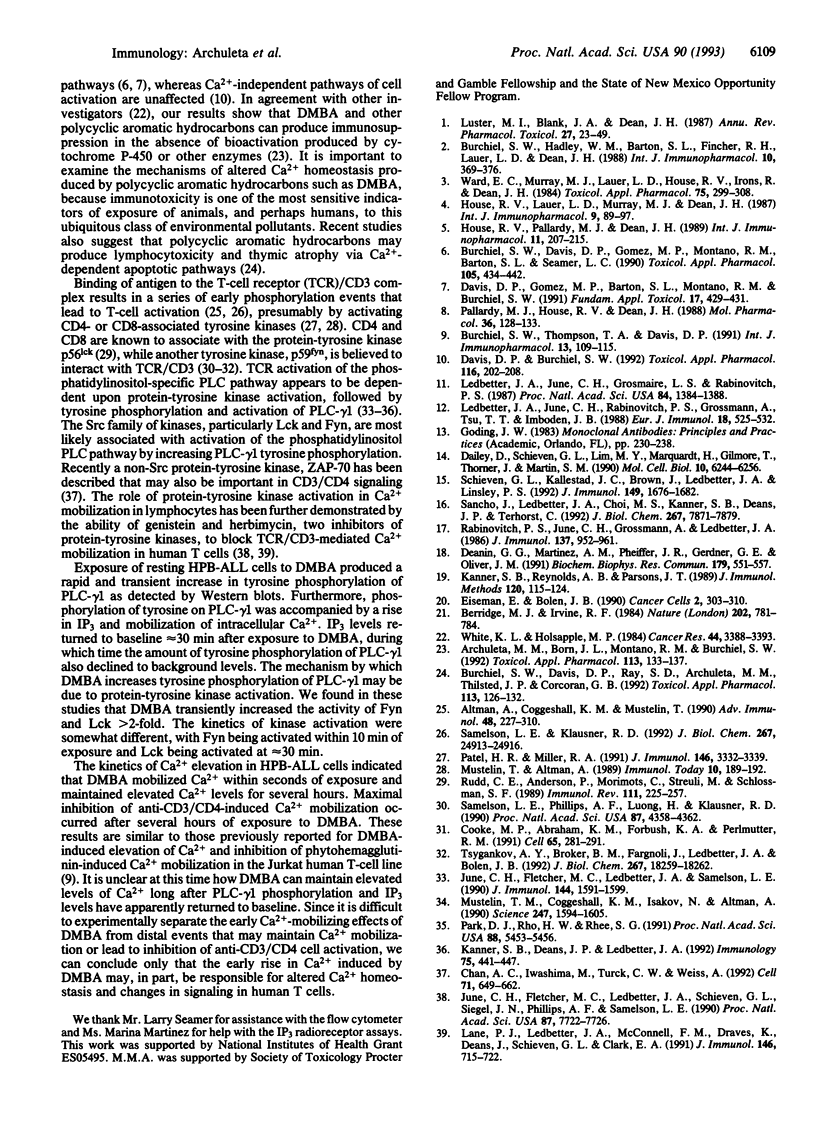Abstract
Previous studies have shown that the immunosuppressive and carcinogenic polycyclic aromatic hydrocarbon 7,12-dimethylbenz(a)anthracene (DMBA) impairs Ca(2+)-dependent transmembrane signaling in human and murine lymphocytes. The purpose of the present studies was to analyze potential mechanisms of immunosuppression by DMBA and to examine effects on Ca2+ homeostasis and antigen-receptor signaling in human T cells. DMBA produced a rapid and sustained increase in Ca2+ levels in HPB-ALL cells by release of cytoplasmic Ca2+. DMBA also inhibited anti-CD3/CD4 mobilization of Ca2+ in HPB-ALL cells, with half-maximal inhibition occurring at approximately 4 hr. Thus, the kinetics for initial Ca2+ mobilization and inhibition of the anti-CD3/CD4 response differed. The rapid rise in intracellular Ca2+ induced by DMBA alone was accompanied by a rapid but transient increase in inositol 1,4,5-trisphosphate and tyrosine phosphorylation of phospholipase C-gamma 1. The pattern of tyrosine phosphorylation induced by DMBA in HPB-ALL cells was remarkably similar to that induced by anti-CD3/CD4 activation. Thus, DMBA-induced phosphorylation may mimic antigen-receptor activation in T cells, which may lead to alterations in antigen responsiveness. The mechanism of DMBA-induced tyrosine phosphorylation of phospholipase C-gamma 1 may have been due to an increase in protein-tyrosine kinase activity, since it was found that DMBA produced a > 2-fold increase in the activity of the T-cell receptor-associated Src-family kinases Fyn and Lck. The kinetics of activation of protein-tyrosine kinases demonstrated that Fyn activity was increased within 10 min of exposure to DMBA, whereas maximal Lck activation required 30 min. Thus, it is likely that the Fyn kinase or other protein-tyrosine kinases may be responsible for the early tyrosine phosphorylation of phospholipase C-gamma 1, which results in inositol 1,4,5-trisphosphate release and mobilization of intracellular Ca2+.
Full text
PDF




Images in this article
Selected References
These references are in PubMed. This may not be the complete list of references from this article.
- Altman A., Coggeshall K. M., Mustelin T. Molecular events mediating T cell activation. Adv Immunol. 1990;48:227–360. doi: 10.1016/s0065-2776(08)60756-7. [DOI] [PubMed] [Google Scholar]
- Archuleta M. M., Born J. L., Montano R. M., Burchiel S. W. Covalent binding of 7,12-dimethylbenz[a]anthracene to lymphoid and nonlymphoid tissues following oral administration to B6C3F1 mice. Toxicol Appl Pharmacol. 1992 Mar;113(1):133–137. doi: 10.1016/0041-008x(92)90017-m. [DOI] [PubMed] [Google Scholar]
- Burchiel S. W., Davis D. A., Gomez M. P., Montano R. M., Barton S. L., Seamer L. C. Inhibition of lymphocyte activation in splenic and gut-associated lymphoid tissues following oral exposure of mice to 7,12-dimethylbenz[a]anthracene. Toxicol Appl Pharmacol. 1990 Sep 15;105(3):434–442. doi: 10.1016/0041-008x(90)90147-m. [DOI] [PubMed] [Google Scholar]
- Burchiel S. W., Davis D. A., Ray S. D., Archuleta M. M., Thilsted J. P., Corcoran G. B. DMBA-induced cytotoxicity in lymphoid and nonlymphoid organs of B6C3F1 mice: relation of cell death to target cell intracellular calcium and DNA damage. Toxicol Appl Pharmacol. 1992 Mar;113(1):126–132. doi: 10.1016/0041-008x(92)90016-l. [DOI] [PubMed] [Google Scholar]
- Burchiel S. W., Hadley W. M., Barton S. L., Fincher R. H., Lauer L. D., Dean J. H. Persistent suppression of humoral immunity produced by 7,12-dimethylbenz(A)anthracene (DMBA) in B6C3F1 mice: correlation with changes in spleen cell surface markers detected by flow cytometry. Int J Immunopharmacol. 1988;10(4):369–376. doi: 10.1016/0192-0561(88)90123-3. [DOI] [PubMed] [Google Scholar]
- Burchiel S. W., Thompson T. A., Davis D. A. Alterations in mitogen-induced calcium mobilization and intracellular free calcium produced by 7,12-dimethylbenz(a)anthracene in the Jurkat human T cell line. Int J Immunopharmacol. 1991;13(1):109–115. doi: 10.1016/0192-0561(91)90031-2. [DOI] [PubMed] [Google Scholar]
- Chan A. C., Iwashima M., Turck C. W., Weiss A. ZAP-70: a 70 kd protein-tyrosine kinase that associates with the TCR zeta chain. Cell. 1992 Nov 13;71(4):649–662. doi: 10.1016/0092-8674(92)90598-7. [DOI] [PubMed] [Google Scholar]
- Cooke M. P., Abraham K. M., Forbush K. A., Perlmutter R. M. Regulation of T cell receptor signaling by a src family protein-tyrosine kinase (p59fyn). Cell. 1991 Apr 19;65(2):281–291. doi: 10.1016/0092-8674(91)90162-r. [DOI] [PubMed] [Google Scholar]
- Dailey D., Schieven G. L., Lim M. Y., Marquardt H., Gilmore T., Thorner J., Martin G. S. Novel yeast protein kinase (YPK1 gene product) is a 40-kilodalton phosphotyrosyl protein associated with protein-tyrosine kinase activity. Mol Cell Biol. 1990 Dec;10(12):6244–6256. doi: 10.1128/mcb.10.12.6244. [DOI] [PMC free article] [PubMed] [Google Scholar]
- Davis D. A., Burchiel S. W. Inhibition of calcium-dependent pathways of B-cell activation by DMBA. Toxicol Appl Pharmacol. 1992 Oct;116(2):202–208. doi: 10.1016/0041-008x(92)90299-8. [DOI] [PubMed] [Google Scholar]
- Davis D. P., Gomez M. P., Barton S. L., Montano R. M., Burchiel S. W. Suppression of local gut-associated and splenic mitogen responsiveness of lymphoid cells following oral exposure of B6C3F1 mice to 7,12-dimethylbenz[a]anthracene. Fundam Appl Toxicol. 1991 Aug;17(2):429–431. doi: 10.1016/0272-0590(91)90231-r. [DOI] [PubMed] [Google Scholar]
- Deanin G. G., Martinez A. M., Pfeiffer J. R., Gardner M. E., Oliver J. M. Tyrosine kinase-dependent phosphatidylinostiol turnover and functional responses in the Fc epsilon R1 signalling pathway. Biochem Biophys Res Commun. 1991 Aug 30;179(1):551–557. doi: 10.1016/0006-291x(91)91406-3. [DOI] [PubMed] [Google Scholar]
- Eiseman E., Bolen J. B. src-related tyrosine protein kinases as signaling components in hematopoietic cells. Cancer Cells. 1990 Oct;2(10):303–310. [PubMed] [Google Scholar]
- House R. V., Lauer L. D., Murray M. J., Dean J. H. Suppression of T-helper cell function in mice following exposure to the carcinogen 7,12-dimethylbenz[a]anthracene and its restoration by interleukin-2. Int J Immunopharmacol. 1987;9(1):89–97. doi: 10.1016/0192-0561(87)90114-7. [DOI] [PubMed] [Google Scholar]
- House R. V., Pallardy M. J., Dean J. H. Suppression of murine cytotoxic T-lymphocyte induction following exposure to 7,12-dimethylbenz[A]anthracene: dysfunction of antigen recognition. Int J Immunopharmacol. 1989;11(2):207–215. doi: 10.1016/0192-0561(89)90073-8. [DOI] [PubMed] [Google Scholar]
- June C. H., Fletcher M. C., Ledbetter J. A., Samelson L. E. Increases in tyrosine phosphorylation are detectable before phospholipase C activation after T cell receptor stimulation. J Immunol. 1990 Mar 1;144(5):1591–1599. [PubMed] [Google Scholar]
- June C. H., Fletcher M. C., Ledbetter J. A., Schieven G. L., Siegel J. N., Phillips A. F., Samelson L. E. Inhibition of tyrosine phosphorylation prevents T-cell receptor-mediated signal transduction. Proc Natl Acad Sci U S A. 1990 Oct;87(19):7722–7726. doi: 10.1073/pnas.87.19.7722. [DOI] [PMC free article] [PubMed] [Google Scholar]
- Kanner S. B., Deans J. P., Ledbetter J. A. Regulation of CD3-induced phospholipase C-gamma 1 (PLC gamma 1) tyrosine phosphorylation by CD4 and CD45 receptors. Immunology. 1992 Mar;75(3):441–447. [PMC free article] [PubMed] [Google Scholar]
- Kanner S. B., Reynolds A. B., Parsons J. T. Immunoaffinity purification of tyrosine-phosphorylated cellular proteins. J Immunol Methods. 1989 Jun 2;120(1):115–124. doi: 10.1016/0022-1759(89)90296-2. [DOI] [PubMed] [Google Scholar]
- Lane P. J., Ledbetter J. A., McConnell F. M., Draves K., Deans J., Schieven G. L., Clark E. A. The role of tyrosine phosphorylation in signal transduction through surface Ig in human B cells. Inhibition of tyrosine phosphorylation prevents intracellular calcium release. J Immunol. 1991 Jan 15;146(2):715–722. [PubMed] [Google Scholar]
- Ledbetter J. A., June C. H., Grosmaire L. S., Rabinovitch P. S. Crosslinking of surface antigens causes mobilization of intracellular ionized calcium in T lymphocytes. Proc Natl Acad Sci U S A. 1987 Mar;84(5):1384–1388. doi: 10.1073/pnas.84.5.1384. [DOI] [PMC free article] [PubMed] [Google Scholar]
- Ledbetter J. A., June C. H., Rabinovitch P. S., Grossmann A., Tsu T. T., Imboden J. B. Signal transduction through CD4 receptors: stimulatory vs. inhibitory activity is regulated by CD4 proximity to the CD3/T cell receptor. Eur J Immunol. 1988 Apr;18(4):525–532. doi: 10.1002/eji.1830180406. [DOI] [PubMed] [Google Scholar]
- Luster M. I., Blank J. A., Dean J. H. Molecular and cellular basis of chemically induced immunotoxicity. Annu Rev Pharmacol Toxicol. 1987;27:23–49. doi: 10.1146/annurev.pa.27.040187.000323. [DOI] [PubMed] [Google Scholar]
- Mustelin T., Altman A. Do CD4 and CD8 control T-cell activation via a specific tyrosine protein kinase? Immunol Today. 1989 Jun;10(6):189–192. doi: 10.1016/0167-5699(89)90322-8. [DOI] [PubMed] [Google Scholar]
- Pallardy M. J., House R. V., Dean J. H. Molecular mechanism of 7,12-dimethylbenz[a]anthracene-induced immunosuppression: evidence for action via the interleukin-2 pathway. Mol Pharmacol. 1989 Jul;36(1):128–133. [PubMed] [Google Scholar]
- Park D. J., Rho H. W., Rhee S. G. CD3 stimulation causes phosphorylation of phospholipase C-gamma 1 on serine and tyrosine residues in a human T-cell line. Proc Natl Acad Sci U S A. 1991 Jun 15;88(12):5453–5456. doi: 10.1073/pnas.88.12.5453. [DOI] [PMC free article] [PubMed] [Google Scholar]
- Patel H. R., Miller R. A. Analysis of protein phosphorylation patterns reveals unanticipated complexity in T lymphocyte activation pathways. J Immunol. 1991 May 15;146(10):3332–3339. [PubMed] [Google Scholar]
- Rabinovitch P. S., June C. H., Grossmann A., Ledbetter J. A. Heterogeneity among T cells in intracellular free calcium responses after mitogen stimulation with PHA or anti-CD3. Simultaneous use of indo-1 and immunofluorescence with flow cytometry. J Immunol. 1986 Aug 1;137(3):952–961. [PubMed] [Google Scholar]
- Rudd C. E., Anderson P., Morimoto C., Streuli M., Schlossman S. F. Molecular interactions, T-cell subsets and a role of the CD4/CD8:p56lck complex in human T-cell activation. Immunol Rev. 1989 Oct;111:225–266. doi: 10.1111/j.1600-065x.1989.tb00548.x. [DOI] [PubMed] [Google Scholar]
- Samelson L. E., Klausner R. D. Tyrosine kinases and tyrosine-based activation motifs. Current research on activation via the T cell antigen receptor. J Biol Chem. 1992 Dec 15;267(35):24913–24916. [PubMed] [Google Scholar]
- Samelson L. E., Phillips A. F., Luong E. T., Klausner R. D. Association of the fyn protein-tyrosine kinase with the T-cell antigen receptor. Proc Natl Acad Sci U S A. 1990 Jun;87(11):4358–4362. doi: 10.1073/pnas.87.11.4358. [DOI] [PMC free article] [PubMed] [Google Scholar]
- Sancho J., Ledbetter J. A., Choi M. S., Kanner S. B., Deans J. P., Terhorst C. CD3-zeta surface expression is required for CD4-p56lck-mediated upregulation of T cell antigen receptor-CD3 signaling in T cells. J Biol Chem. 1992 Apr 15;267(11):7871–7879. [PubMed] [Google Scholar]
- Schieven G. L., Kallestad J. C., Brown T. J., Ledbetter J. A., Linsley P. S. Oncostatin M induces tyrosine phosphorylation in endothelial cells and activation of p62yes tyrosine kinase. J Immunol. 1992 Sep 1;149(5):1676–1682. [PubMed] [Google Scholar]
- Tsygankov A. Y., Bröker B. M., Fargnoli J., Ledbetter J. A., Bolen J. B. Activation of tyrosine kinase p60fyn following T cell antigen receptor cross-linking. J Biol Chem. 1992 Sep 15;267(26):18259–18262. [PubMed] [Google Scholar]
- Ward E. C., Murray M. J., Lauer L. D., House R. V., Irons R., Dean J. H. Immunosuppression following 7,12-dimethylbenz[a]anthracene exposure in B6C3F1 mice. I. Effects on humoral immunity and host resistance. Toxicol Appl Pharmacol. 1984 Sep 15;75(2):299–308. doi: 10.1016/0041-008x(84)90212-6. [DOI] [PubMed] [Google Scholar]
- White K. L., Jr, Holsapple M. P. Direct suppression of in vitro antibody production by mouse spleen cells by the carcinogen benzo(a)pyrene but not by the noncarcinogenic congener benzo(e)pyrene. Cancer Res. 1984 Aug;44(8):3388–3393. [PubMed] [Google Scholar]





